O’odham Piipaash Language Program

Welcome to the O’odham Piipaash Language Program
Our Vision
To save the Onk Akimel O’odham and Piipaash Languages.
To develop speakers at all age levels.
To hear the languages of the O’odham and Piipaash being spoken in all domains of the Salt River Pima-Maricopa Indian Community.
Responsibilities
To provide opportunities for SRPMIC members to learn and acquire the O’odham and Piipaash Languages using a variety of structured, natural and traditional approaches.
To nurture and cultivate the O’odham and Piipaash Languages by planning, promoting and providing opportunities to use and experience the languages in a broad range of contexts.
To develop and distribute materials to SRPMIC members for the purpose of O’odham and Piipaash Language advocacy, promotion, instruction, development, and general awareness.
To research, record, and document the O’odham and Piipaash Languages for maintenance and preservation to assure the survival and vitality of the Languages for SRPMIC members.
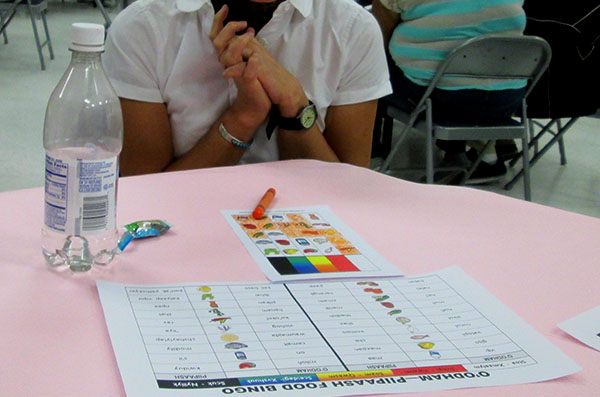 What We Have to Offer
What We Have to Offer
O’odham Immersion and Piipaash Language Classes
O’odham and Piipaash Language Based Cultural Arts Classes
Quarterly O’odham and Piipaash Language Based Community Social Activities
Assist community members and departments with translations, spellings and cultural information
Organized gatherings for Elders pertaining to the O’odham and Piipaash Languages
Provide interview opportunities for SRPMIC tribal Elders and cultural practitioners (e.g. singers, dancers, basket weavers, potters, etc.)
Background and Status of the O’odham Ñiokĭ (Pima Language)
The O’odham language is part of the large language family known as Uto-Aztecan. More specifically, it belongs to the subfamily called Tepiman. The Tepiman group of Uto-Aztecan languages extends from Phoenix, Arizona to Durango, Mexico. The Tepiman languages, though related, are not all mutually intelligible. However, local O’odham speakers can communicate to some degree with O’odham living a thousand miles south, deep into Mexico.
In the state of Arizona, O’odham is spoken by members of the Salt River Pima-Maricopa Indian Community, Gila River Indian Community, Ak-Chin Indian Community and Tohono O’odham Nation. There are distinct dialect differences that exist between (and within) each of these communities, but the differences are minimal and speakers can generally communicate with little or no difficulty. One of the more obvious differences is that Tohono O’odham uses a /w/ where Akimel O’odham uses a /v/.
According to Ethnologue: Languages of the World, there were an estimated 14,000 O’odham speakers in the United States as of 2007. Most current estimates would indicate the present number of speakers is much lower. Nevertheless, the O’odham language has one of the largest overall number of speakers as compared other indigenous languages of the United States. The vast majority of those speakers, however, reside in the more isolated desert villages of southern Arizona. The SRPMIC is the northernmost O’odham-speaking community and is enveloped by the Phoenix metropolitan area. Consequently, fewer than 3% of enrolled SRPMIC members are fluent O’odham speakers.
Ethnologue classifies the O’odham language as ‘Threatened’, defined as, “The language is used for face-to-face communication within all generations, but is losing users.” Within the SRPMIC, however, the O’odham language is more accurately classified as ‘Moribound’, defined as, “The only remaining active users of the language are members of the grandparent generation and older.”
O’odham language survival is an increasingly important issue for the SRPMIC, and revitalization efforts are in place to nurture future speakers. As a result of these efforts, children in the Community now know more O’odham language than their parents (in many cases), though they are yet far from fluent. We hope this website will be a supportive resource to new learners of all ages and will contribute to the overall health and wellbeing of our O’odham language.
Visit our O’odham Orthography page for more detailed information on the O’odham writing system used in Salt River.
Background and Status of the Piipaash Chuukwer (Maricopa Language)
The Piipaash language is part of the Yuman language family. The Yuman languages are spoken by tribes throughout the western half of Arizona, Southern California and Baja California, Mexico. The Yuman language family consists of four major branches:
River – Maricopa, Quechan, Mohave
Pai – Yavapai, Hualapai, Havasupai, Paipai
Delta California – Cocopah, Kumeyaay
Kiliwa – (a single language)
Although the Yuman languages are related, they are not all mutually intelligible. According to one study conducted in 1956, Piipaash speakers found Quechan 98% intelligible and Mohave 67% intelligible. The same test suggested that Piipaash speakers found the Pai languages intelligible within a range of 10%-18%. The remaining Yuman languages were not included in that study but the percentage of intelligibility for the Delta-California languages would have likely tested slightly higher than the Pai languages, whereas Kiliwa would have likely tested lower.
Maricopas have not always been a single homogenous group with regard to cultural identity and language. Modern Maricopas are descended from an historical amalgamation of closely related and allied Yuman groups who, prior to the 1820s, resided in various places along the Gila and Colorado Rivers. Each of these groups formerly maintained distinct cultural identities and dialects:
Piipaa Nyaa (aka Thxpaa Nyaa)
Xalychidom Piipaash
Kavelychidom Piipaash
Xalkawaam
Kaxwaan
As these groups merged in the early 1800s, so too did their dialects. Over time, the distinct dialects largely blended, but not completely. Some amount of diversity still exists among Piipaash speakers. Today there are two communities of Piipaash speakers. The west side of the Gila River Indian Community is home the larger population of Piipaash (historically spelled Pee Posh). Those of us living in the Lehi District of the Salt River Pima Maricopa Indian Community are primarily identified as Xalychidom Piipaash.
According to the Ethnologue: Languages of the World, there were an estimated 100 Piipaash speakers as of 2007. Most current estimates would indicate the current number speakers is much lower. The Piipaash language is considered to be among the more endangered indigenous languages in the United States. The actual number of fluent first-language Piipaash speakers in the SRPMIC is fewer than ten.
Ethnologue classifies the Piipaash language as Shifting, defined as, “The child-bearing generation can use the language among themselves, but it is not being transmitted to children.” In the SRPMIC and elsewhere, the Piipaash is more accurately described as Nearly Extinct, defined as, “The only remaining users of the language are members of the grandparent generation or older who have little opportunity to use the language.”
Piipaash language survival is an increasingly important issue for the SRPMIC, and revitalization efforts are in place to nurture future speakers. As a result of these efforts, children in the Community now know more Piipaash language than their parents (in many cases), though they are yet far from fluent. We hope this website will be a supportive resource to new learners of all ages and will contribute to the overall health and wellbeing of our Piipaash language.
Visit our Piipaash Orthography page for more detailed information on the Piipaash writing system used in Salt River.
O’odham Orthography
Pronunciation Guide
The O’odham Piipaash Language Program uses a modified version of the Alvarez-Hale Orthography developed by Dr. Albert Alvarez (Tohono O’odham) and Dr. Kenneth Hale.
- This modified version of the Alvarez/Hale orthography uses twenty-one consonants and five vowels. Other symbols are used to determine the length of the vowel. (The following letters are not used: f, q, r, v, x, & z).
-
To accommodate local dialect these symbols were added to the Alvarez/Hale orthography: d & v.
-
* The location of stress within a word – the stress on most O’odham words is consistently in initial position (first syllable).
- * The glottal stop (‘) is a sound produced by a stoppage of air in the throat and is also found in certain expressions in English. For example, “uh-oh”, as in “uh-oh, I think we’re in trouble!”
-
* The vowel sounds in O’odham can be drawn out to a long sound or cut off as a short sound. The sound of a long or short vowel does not change – it is simply held for a longer or shorter duration.
A colon (:) following a vowel represents a long vowel. Long vowels can appear in any syllable of a word.
A vowel with a breve (˘) over it represents a short vowel. Short vowels, which are almost whispered, usually occur at the end of a word.
-
* Plurals are created by reduplication of a singular word: reduplication of the first consonant and vowel, or just the initial vowel. (Example: gogs – gogogs or mi:tol – mimi:tol).
-
* Used in lower case, o’odham refers simply to people, and in upper case, O’odham refers to speakers of the O’odham language.
*Zepeda, Ophelia. “The Papago Grammar.”
Consonants
| Letter | Sound | O’odham | Milga:n |
| b | big | ban | coyote |
| c | chip | cehia | little girl |
| d | this | do’ag | mountain |
| ḍ | but | taḍ | foot |
| d | dam | judum | bear |
| g | go | gogs | dog |
| h | hot | huñ | corn |
| j | job | ju:k | rain |
| k | kiss | ka:lit | wagon |
| l | rolling “l“ | lial | money |
| m | miss | mi:tol | cat |
| n | no | nalaṣ | orange |
| ñ | canyon | ñulaṣ | peach |
| p | pot | pi:las | pear |
| s | see | siṣpakuḍ | safety pin |
| ṣ | ship | ṣuṣk | shoes |
| t | thin | taṣ | sun |
| v | vine | violi:n | violin |
| w | what | wioṣa | face |
| y | yes | yavĭ | key |
Vowels
| Letter | Sound | O’odham | Milga:n |
| a | father | ba’ag | eagle |
| e | earth | eldagĭ | skin |
| i | machine | ispul | spur |
| o | all | oks | old woman |
| u | brute | uvĭ | female |
Long Vowels
| Letter | O’odham | Milga:n |
| a: | ma:gina | machine |
| e: | e:ed | blood |
| i: | i:bhai | prickly pear |
| o: | o:b | apache |
| u: | u:s | wood |
Short Vowels
A few words use vowels that have a symbol above them called a breve. A vowel with a breve above it is only found at the end of words and can be difficult to hear. It may simply sound like an aspiration.
| Letter | Sound | O’odham | Milga:n |
| ĭ | an aspiration | svegĭ | red |
Diphthongs
When two vowels occur together in an Oʼodham word, the resulting diphthongs can produce new sounds.
| Letter | Sound | O’odham | Milga:n |
| ai | aisle | vainom | knife, object made of metal |
| ei | gooey | i:gei | fell down |
| oi | poi | ṣoiga | pet |
| ui | oui | kui | mesquite tree |
Engwa
| Letter | Sound | O’odham | Milga:n |
| ŋ | thing | *ca:ŋgo | monkey |
*In Salt River we use the word “Gogs O’odham” to describe monkey. (Some O’odham dialects use ca:ŋgo for monkey)
Piipaash Orthography
The Xalychidom Alphabet
The alphabet we are using is one that has been developed by a group of tribal members from the Community. We use Roman symbols as the English alphabet does, but they do not necessarily represent the same sounds as English letters. So, if you go about trying to read Piipaash as if it were English, you will likely pronounce the words wrong. You will have to learn this writing system letter by letter, and leave English rules aside
Some Maricopa sounds do not exist in English (and vice-versa), so it can be difficult to describe them to English speakers. In the second column below, an approximate English equivalent is provided.
Stress
Stress falls on the final syllable of the root word (e.g., pii-paash΄ not pii΄-paash)
Pluralization
In Piipaash, most nouns do not have plural forms. The same noun form is used in reference to one or many (a few nouns that reference people do have plurals). Verbs, however, have forms that indicate the subject is either singular (1), dual (2) or plural (3+).
Vowels
The Piipaash alphabet contains five (5) short vowels and five (5) long vowels. The principal difference between long and short vowels is the duration for which they are held. They are as follows:
Short Vowels
| Letter | Sound | Piipaash | English |
| a | like the /a/ in father | ’a | saguaro cactus |
| e | usually like the /e/ in pet | ’ave | snake |
| i | usually like the /i/ in sit | dish | seed |
| o | like the /o/ in go | iitho | stomach |
| u | like the /u/ in flute | kuchar | spoon |
Long Vowels
| Letter | Sound | Piipaash | English |
| aa | like the /a/ in father | paap | potato |
| ee | usually like the /a/ in play | ’avee | mouse |
| ii | usually like the /ee/ in cheek | mariik | bean |
| oo | like the /o/ in go | iidoo | tooth/teeth |
| uu | like the /u/ in flute | ’uuvs | grape |
Consonants
The Piipaash alphabet contains twenty five (25) consonant sounds.
| Letter | Sound | Piipaash | English |
| ch | like the /ch/ in chair | chii | fish |
| d | like the /th/ in there | thadish | corn |
| f | like the /f/ in fish | kafee | coffee |
| k | like the /k/ in kiss | kosh | pig |
| kw | like the /qu/ in queen | kwnxo | basket |
| ky | like the /cu/ in cute | mathkyaaly | ramada |
| l | like the /l/ in land | lames | table |
| ly | like the /ll/ in million | kalyaap | prickly pear |
| m | like the /m/ in man | maa | milk |
| n | like the /n/ in name | npee | wheat |
| ng | like the /ng/ in song | narangk | orange |
| ny | like the /ny/ in canyon | nyaa | I/sun/east/day |
| p | like the /p/ in spin | paan | bread |
| q | like /k/ but pronounced further back in the throat | vqor | fruit |
| qw | like /kw/ but pronounced further back in the throat | qwaaq | deer |
| r | rolled like Spanish /rr/ in perro | rav | chili |
| s | like the /s/ in salt | sny’ak | woman |
| sh | like the /sh/ in share | shiyal | money |
| t | like the /t/ in talk | mat | dirt/earth |
| th | like the /th/ in thousand | tha’ur | chair |
| v | like the /v/ in victory | va | house |
| w | like the /w/ in win | iiwaa | heart |
| x | like the German /ch/ in Bach | xa | water |
| xw | like the /x/ but with rounded lips | milxwee | skunk |
| y | like the /y/ in yes | iiyaa | mouth |
Diphthongs
Diphthongs are most easily explained as instances where one vowel glides into a different vowel. Below are some common diphthongs found in Piipaash.
| Letter | Sound | Piipaash | English |
| oy | like the /oy/ in boy | ’akooy | older woman |
| aw | like the /ow/ in cow | xaly’aw | rabbit / cottontail |
| ew | no similar sound in English | chew | pottery |
| ay | like the /ay/ in cayenne | ’iikway | cow |
| uy | like the /uey/ in ‘chop suey’ | kwiduy | watermelon |
Glottal Stop
This little mark that looks like a comma signifies that the glottis (throat) is closed on this part of the word. When it occurs in the middle of a word, it is a quick catch or pause, as in the expression ‘uh-oh.’
salt – s΄ii
Glottal stops are barely perceptible at the beginning of many words. They are most perceptible on words that begin with a vowel. Vowel initial words without a glottal stop in front will sound similar to English words beginning with the letter h. In other words, air is flowing freely through the glottis (throat). If the vowel is preceded by a glottal stop, that means no air is passing through the closed throat, therefore, no English /h/ sound.
iiwaa (heewaa) – his/her/its heart
’iiwaa (eewaa) – my heart
Stress
The main stress is always on the last syllable of the root word.
Events and Classes
Please Note: All classes are open to enrolled SRPMIC community members. Ages vary based on classes, all participants under the age of 16 must be accompanied by a responsible adult. To sign up for any class participants must sign-up in person at the Cultural Resources Department, Monday – Friday, 8:00am – 5:00pm.
All events and classes are posted on the CRD Events Calendar, Community Announcements, and in the O’odham Action News.
*Class dates and times are subject to change, please call to verify dates listed.
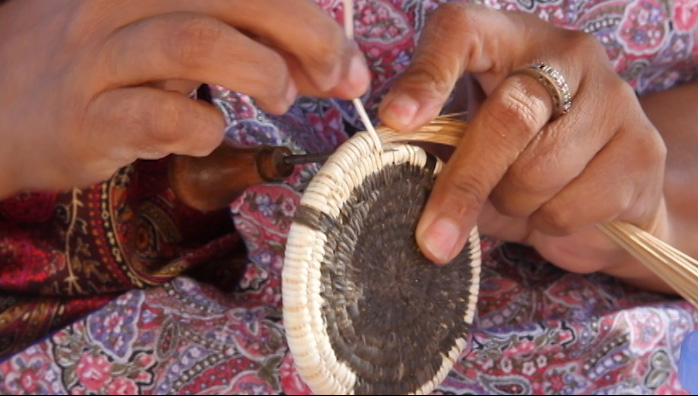 Hua Mascamik
Hua Mascamik
Willow basket weaving classes are held to teach the process of gathering, preparing and ultimately starting a willow basket. Participants will also be taught the language terminology used in making baskets.
Open to interested enrolled SRPMIC member women, under 16 must be accompanied by a responsible adult female.
O’odham Niokĭ Hemapik
Monthly, February-December | 10am-2pm | CRD Main Classroom
Monthly Elder gatherings are held to bring fluent O’odham language speakers together for the purpose of language recording, translation requests and most importantly to provide a place where elders and speakers can gather to speak to each other in the O’odham language.
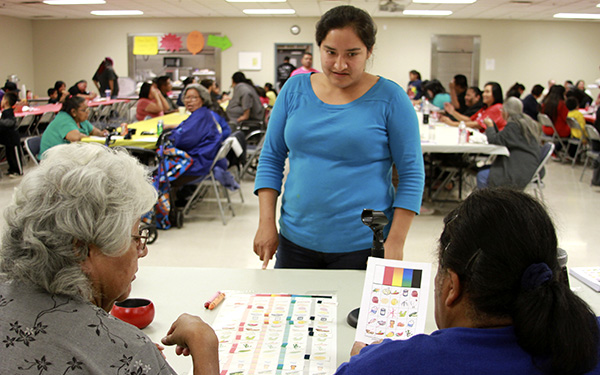 O’odham Piipaash Quarterly Bingo
O’odham Piipaash Quarterly Bingo
January, April, July, October
Playing games to learn a language can be a positive and rewarding experience for learners due to repetitive word usage. Bingo games are designed to teach learners how to say simple everyday words, topics include: household items, animals, foods, colors and numbers. Open to interested SRPMIC members of all ages.
O’odham Dress Making Class
O’odham traditional dress making classes are held to teach how dresses are made while incorporating the O’odham language used while sewing. Classes are scheduled based on beginner, intermediate or advanced sewing experience.
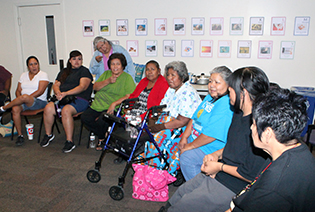 O’odham Immersion Class
O’odham Immersion Class
Spring session: February – May*
Fall Session: September – December*
Language immersion techniques and strategies are utilized to provide a positive, encouraging and rewarding language learning experience. These classes are taught in the O’odham Language with limited use of English. For more detailed information on immersion techniques please visit AILDI.
Class is open to learners of all levels.
O’odham Social Dance Class
O’odham Social Dance Class is offered to teach social dance protocols, gender roles, the history and meanings of the songs, and the importance of gathering to reinforce family and community.
O’odham Singing Class
O’odham Singing Class is offered to teach social singing protocols, gender roles, the history and meanings of the songs, and the importance of gathering to reinforce family and community.
Piipaa Kuutsh Matasheevm
Monthly, January – October | 10am-2pm | CRD Main Classroom
Monthly Elder gatherings are held to bring fluent Piipaash language speakers together for the purpose of language recording, translation requests and most importantly to provide a place where elders and speakers can gather to speak to each other in the Piipaash language.
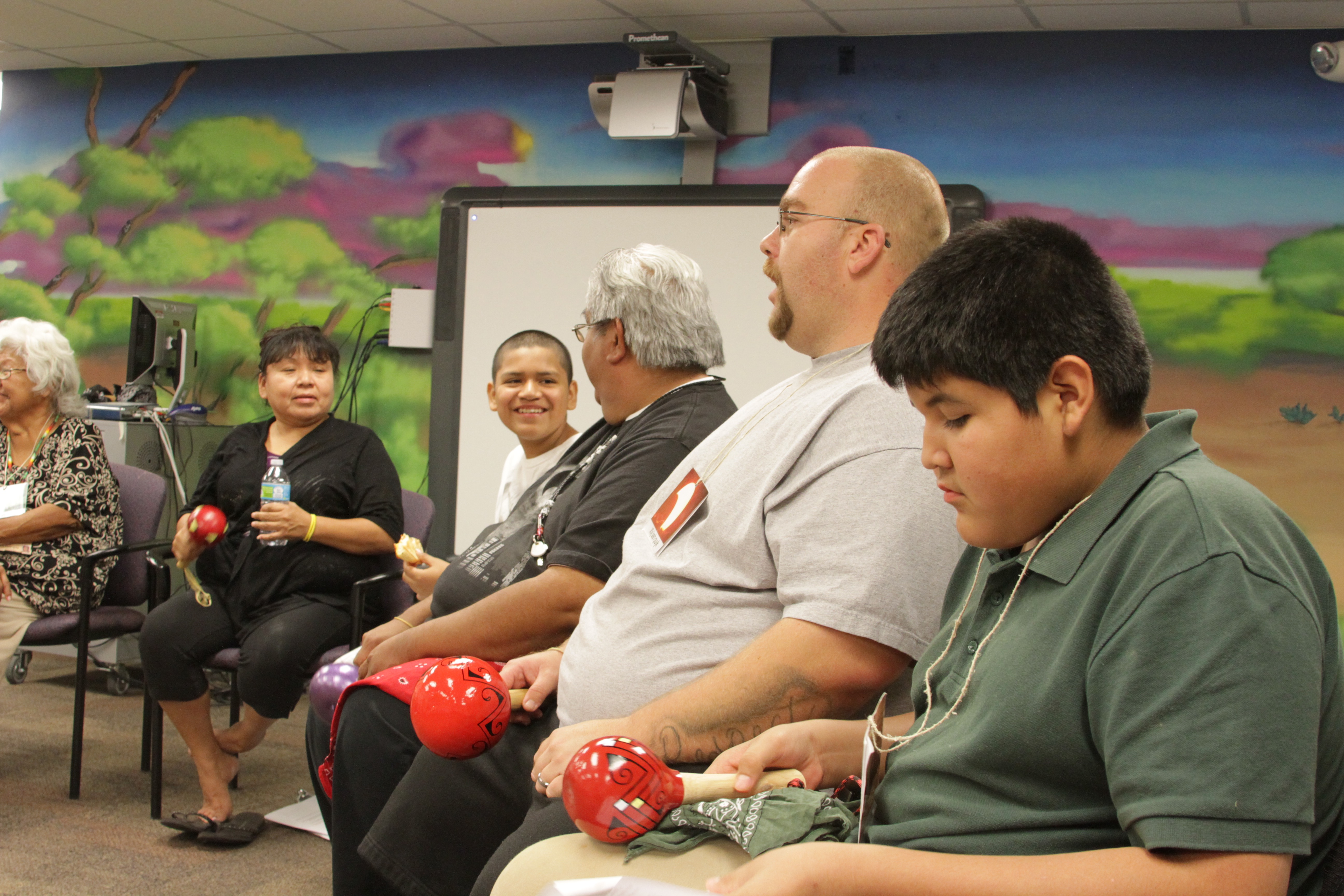 Piipaash Songs Class
Piipaash Songs Class
Piipaash Songs Class is offered to teach social singing protocols, gender roles, the history and meanings of the songs, and the importance of gathering to reinforce family and community.
Piipaash Language Class
Fall Session: September – December*
Spring session: February – May*
Some of the early lessons will include colors, animals, numbers, and other basic every day phrases. This is designed for the learner with little to no Piipaash language knowledge.
Piipaash Dress Making Class
Piipaash traditional dress making classes are held to teach how dresses are made while incorporating the Piipaash language used while sewing. Classes are scheduled based on beginner, intermediate or advanced sewing experience.
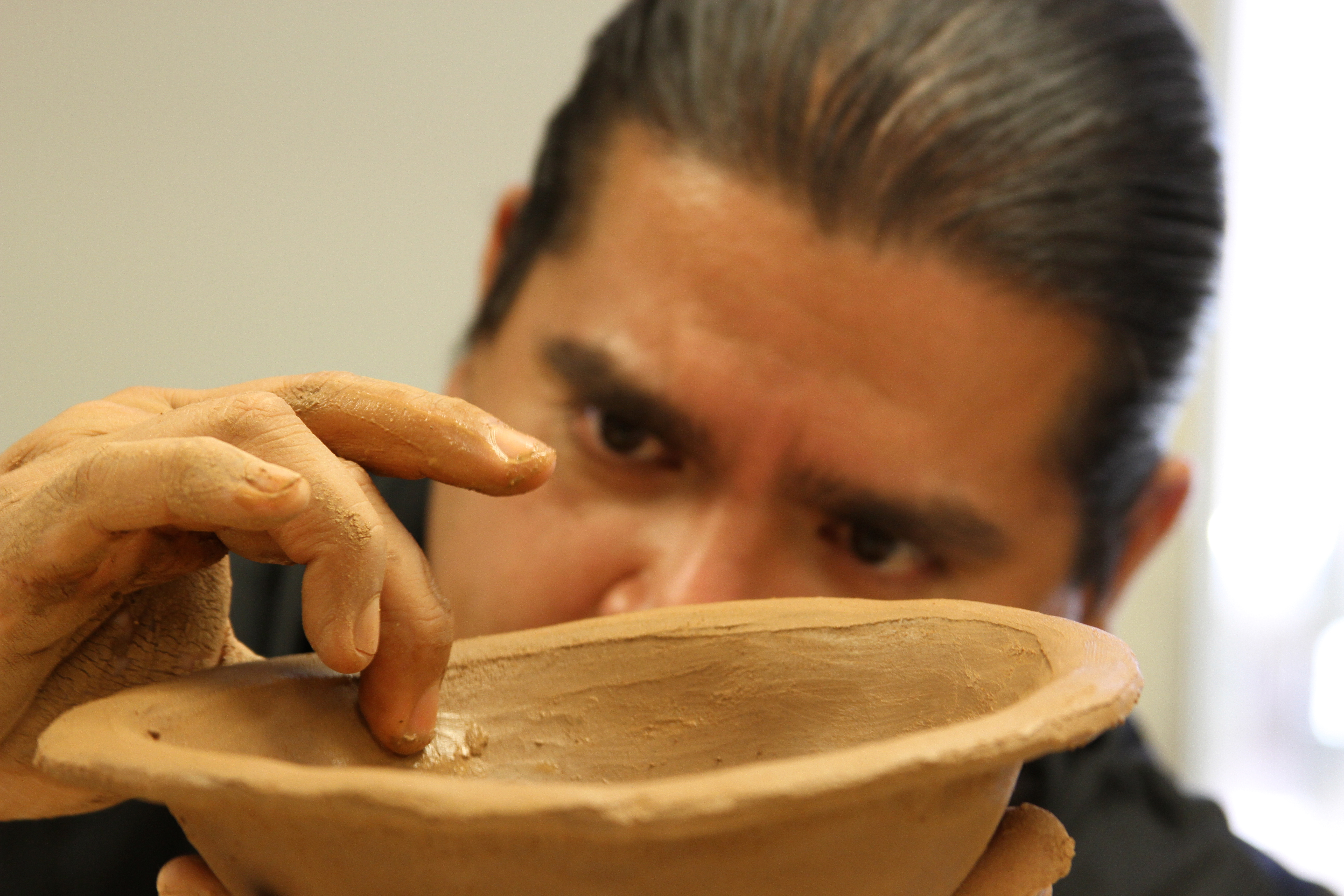 Pottery Class
Pottery Class
Pottery classes are held to teach how to make pottery using clay from this area. Participants will also be taught language terminology used in making pottery. Classes are based on beginner, intermediate or advanced skill level.
Vospo Dance Class
This Piipaash dance class is offered to teach this style of dance. Participants will learn song meanings and how to make dance sticks.

